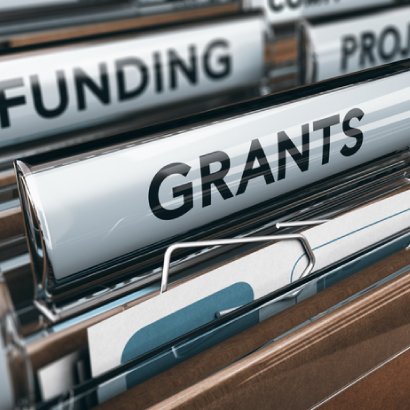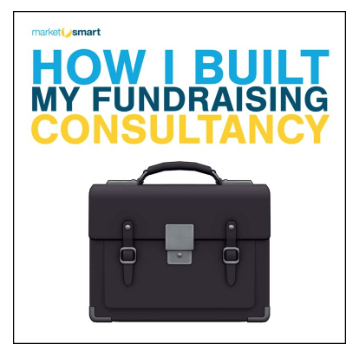Listen to Elise talk about growing Saltzberg Consulting
Elise shares her story on the Market Smart's podcast, "How I Built My Fundraising Consultancy"
Market Smart is a company that helps charities enhance their fundraising through marketing and technology. (If you're a fundraiser who wants to boost lead generation and cultivation efforts, see below for valuable free resources.) I learned about Market Smart when they asked me to be a guest on their podcast,”How I Built My Fundraising Consultancy.”
It was a great experience, and I invite you to listen to the program. (If you want to jump to certain topics, use the Topic Timestamps below to guide you or read the transcript below.)
Topic Timestamps
Introduction [00:00]
What inspired you to start your business? [02:33]
Home/Client Time Split? [03:21]
Are your clients local? [03:56]
Where did your interest in grants come from? [04:18]
Your background in psychology? [05:09]
How’d you decide to get into fundraising? [05:45]
What aspects of fundraising do you enjoy? [07:34]
What was it like working for a larger national nonprofit? [08:14]
How did you expand to include now 6 other consultants? [09:32]
Grant Research [10:36]
How has the business changed since you started it? [12:25]
What kind of clients do you work with? [13:21]
The “Are You Ready” form [14:56]
Any tough lessons you’ve learned? [16:16]
What are your favorite tools? [16:45]
Lightning Round [20:03]
Free Market Smart Resources for Fundraisers
Here are links to just some of their FREE fundraising resources:
Blogs: https://imarketsmart.com/smartideas/
Podcasts: https://imarketsmart.com/podcast/
Webinars: https://imarketsmart.com/category/resources/webinars/
PODCAST TRANSCRIPT
Introduction
Welcome to, “How I Built My Fundraising Consultancy” the stories behind the people driving results in the nonprofit sector.
We're here today with Elise Saltzberg. Welcome to the podcast. First off, please introduce yourself and what Saltzberg Consulting does.
Saltzberg Consulting is a fundraising consulting firm. I would say about 80% of what we do is grant related, either grant prospecting or grant writing, grant editing, grant reporting. The other 20% would be every other sort of fundraising, like annual fundraising and major gifts. I tend not to do much with capital campaigns and I also don't get involved too much with special events. If one of my clients wants to throw a party, I usually refer them to someone else.
Is the decision not to work with capital campaigns just because it is such a monumental endeavor to undertake?
There are just other consulting firms out there that do that. I let them
do their thing and they let me do my thing.
The Inspiration to Start
So what inspired you to start your business almost twenty years ago?
I had been working at the Center on Budget and Policy Priorities in Washington DC and I live in Baltimore so I was taking the MARC train down to DC and the commute was kind of getting to me. I had little kids and after awhile I just couldn't do the commuting anymore. I was a stay home mommy for a while and then I decided it was time to go back to work.
I knew I didn't want to go back to Washington so I started my own consulting practice, primarily so I could also be a mom at the same time. It worked out really well, because now my commute is from the upstairs of my house to the downstairs of my house.
Dividing Time Between Home and Clients
That's awesome. I’m very familiar with the MARC train. I've taken it many times from the airport back to home in DC where I'm based out of. So how do you split your time between being on-site at clients' offices versus working at your house?
Almost all of my work is done from home. I have a home office that's got everything that you could imagine. I have a couple of clients I've never actually met in person. Between email and phone calls, there's never been a reason to meet them in person.
I would say that at least once a week I like to get out of the house either go meet with a client or a prospective client or a colleague just sit and talk shop.
Where the Clients Are
And do you find most of your clients are locally based or do you try to branch out to other parts of the country?
Most of my clients are here in Maryland I have a couple who are outside of Maryland. Within Maryland, it's primarily Baltimore County and Baltimore City. I have a few in Prince George's County and somebody in Hagerstown. But mostly it's local.
Developing an Interest in Grant Writing
You mentioned grants was a big part of what your consultancy does. Where did your initial interest in that kind of work come from?
I figured out that I wrote my first grant in 1981. I know I'm dating myself!
I was living in Anderson, Indiana, and I was the Executive Director of an organization called Women's Alternatives. As part of the job of an Executive Director, I was doing a lot of fundraising, and the grantwriting part of it came very easily to me. My mother's a high school English teachers, so I learned how to write. That was where I found my most success in subsequent jobs. I always lean towards that part of the fundraising.
When I was at the Center on Budget and Policy Priorities, nearly all the funding at that time came from foundations. So grant writing was a big part of what I did.
Educational Background
Something I noticed in your background was that in college you studied psychology. Did that have any kind of influence on your perspective for the work you do in fundraising?
It was actually animal behavior in experimental psychology. I wasn't counseling that much or analyzing people or anything like that. I worked with rats and mice in the lab. What I do now isn't directly related to that, but I learned science and I learned how to be a critical thinker. That would certainly help anybody in any part of their life.
Becoming a Professional Fundraiser
That certainly would help. How’d you decide that you wanted to actually start working for nonprofits and do fundraising work?
I kind of fell into it. I was in grad school at Indiana University in Bloomington, Indiana. As I said I was working with rats and mice it was bothering me, because I felt like we were kind of torturing these animals – not so much in my lab but in the labs next to me were cats and dogs and chimpanzees, and they were planting electrodes in their brains and doing all kinds of things that I thought were just terrible.
In my lab the only thing that we did was starve the animals because we had to keep them on 80% body weight to get them to perform the behaviors that we were training them in. I would go in on the weekends and feed the pigeons and the rats and so Monday mornings everybody's experiments were all messed up. But anyway, I did that for a year and I just couldn't do it anymore so I left.
I was married at that time, and my husband got a job in Terre Haute, Indiana. Then we moved to Anderson, Indiana and I became a counselor at Women's Alternatives, as I mentioned. This was a shelter for battered women and their children, and we had services for rape crisis survivors. I was a counselor for three years. When the Executive Director was leaving, the Board asked me to apply for the Executive Director position.
As part of the interview they asked me if I knew how to raise money and write grants. I said, "oh yeah, sure I can do that.” They hired me as the Executive Director and I found out pretty quickly that a big part of the job of an Executive Director for that type of an agency is raising money and that was the part that I really liked the best. I was really good at it, so every job I've had since then has always been a fundraising position.
The Joys of Fundraising
What aspects of fundraising do you really enjoy?
Certainly building relationships with donors is a big big part of fundraising. It’s something that some organizations don't really understand.
Sometimes a client or a prospective client will call me and say, "Can you write a template grant for us that we can send around to a bunch of different foundations?” No, I won't do that because every funder is different and you have to talk to them first and build the relationship before you just blindly send grant applications.
It's like applying for a job and proposals are your cover letter. It’s very obvious if you don't know anything about the company you're applying for.
Working with NonProfits – Large and Small
Exactly. What was it like transitioning from a very local nonprofit in Indiana to a much more you know national organizations like Friends of the Earth?
Well the scale was much different. Our annual budget at Women's Alternatives was about $160,000. I think at Friends of the Earth we were raising about ten times that much. When I left the Center on Budget and Policy Priorities, we were about $4 million annual budget. Now it's probably $40 million annual budget.
That’s a big jump. Did the work you did feel different with the scale being so much different – or did it feel kind of the same, just with different numbers?
It was definitely different at the Center on Budget. You're dealing with the big boys. We would be talking to the people at the Ford Foundation and the Rockefeller Foundation and the board of directors was, and still is, a nationally recognized board with really, really incredibly wonderful people on it. Not to knock Women's Alternatives, but the board there was nice local people who wanted to help these families. So, yes it was on a different level.
Building the Business – Bringing on Associates
Your business now has grown to include six other consultants. When did you start expanding, and what roles needed to be filled at the very beginning of that expansion?
When I started out in 2000 as a sole proprietorship, I had a few clients. My first client was the Center on Budget and Policy Priorities. I think it’s true for a lot of start ups that the first client of the consultancy is your former employer. I grew from there and I grew to the point where I really had more work than I could do myself.
I had a friend who was available, and it kind of fell into place. She's still one of my associates. The associates do primarily the grant writing and I'm doing more editing than writing, which is fine with me and it's fine with them. I have very strong writers on my team.
Occasionally my associates work directly with a client, but most of the time it comes through me. It’s still Saltzberg Consulting, and because my name is on it I keep pretty tight quality control on the finished product.
With grant writing there's quite a bit of research involved in drafting proposals, and those six consultants are doing that work as well, during that writing process?
We have a saying in the field, “If you've seen one foundation, you’ve seen one foundation.” Every foundation is different. They all have their own special challenges. For example, the majority of applications are now done through online portals, but they’re all different. Some of the formats are very tight – you might have 800 characters to write your mission statement, your vision statement, your organizational history, and what you're proposing to do now. Other ones are more open-ended and you can write as much as you want. Some foundations are still doing paper applications and want you to submit 11 copies, so that they can give them to their 11 board members. You have to make copies and bring them to the organization.
You have to give them what they want, and that's part of the deal. They're the ones with the money, and if they say they want 11 copies you have to make 11 copies. The part that’s a little bit frustrating is that they really want you to keep your administrative costs low – like zero –but these copies, which are part of administrative costs, are 15 cents a page!
Evolution of the Business
How has business changed since you began – is it just that you have more work and you’re editing instead of doing the original writing?
I'm still the one who has the primary contact with the clients. I usually have 10 to 12 clients going at a time. For some clients, I’m basically their development staff, and they just say, “You write it will sign it and they really just kind of let me do my thing. Other clients are much more hands-on. They want to see draft number 1, draft number 2, draft number 5, draft number 7, etc.
That's unusual. Most of the time when I give a draft to a client, it's a pretty solid close-to-final version. I’ll use little comment boxes in the margin or yellow highlighting to say, “Look at that section on page 3. That's the part that you really need to focus on.” That’s what they'll focus on and the rest of it they might look at it or they might not.
Finding the Right Clients
What kind of clients do you work with?
I have education, housing, community development, disabilities – just about every category out there I have in my portfolio. If I had to say what my sweet spot is, it's more based on their annual budget. Most of my clients are in the range of about a half a million up to about $4-5 million.
If they have a bigger budget than that, they don’t really need me, because they have their own development department. I do have some large clients that they use me when their own staff is at capacity and need extra help.
Clients who are smaller than about $500,000 a year annual budget may need my help, but they don't have money to pay me. And when you're going after Foundation grants or government grants, if you're a really small organization with one or two staff people the reality is that you're not going to be competitive with most grant applications.
Foundations want to see that you've got the infrastructure to do whatever it is that you're proposing to do. A lot of foundations are leery of going for a really small organization that just doesn't have the capacity or that's an all-volunteer organization.
When Potential Clients Aren’t a Good Fit
I was exploring your website and notice that you have this, "Are You Ready to Apply for a Grant?” page. Has that been a useful tool for gaining new business?
It is amazingly useful. It's not a tool for getting new clients. It’s a tool for not getting new clients.
So it's like a filter?
Exactly. If somebody calls me and I can tell within you know a 10 or 15 minutes phone call that they're not ready, what I’ll do is I'll send them to my website and have them go through that little checklist and come back when they are ready. It’s a waste of my time and their money if they really don't have the things in place that you need to apply to for grant funding, such as:
- Do you have a program?
- Do you have a way of measuring your outcomes?
- Do you have a board of directors?
- Do you have a 501(c)(3) designation?
By the way, if you don't have a 501(c)(3) you can always get a fiscal sponsor, so I don’t want to leave the impression that you’re not ready if you don't have a 501(c)(3), because that's not true. You do need to have a real program, and you really need to have a plan for operating your program and measuring your program’s impact. If you don't have all those things, it's just not going to be a good fit for you to go apply for grants.
Hard Lessons
Are there any hard lessons you learned in the first couple years – if you were doing again what would you do differently from day one?
Just to not bite off more than I can chew. At the beginning, I was very reluctant to bring in associates. I just wanted to do everything myself. I had this idea that it wasn't right to make money off of other people's labor. That’s the anti-capitalism part of me. In the first couple years that was definitely an issue for me.
Grant Research
Do you have any favorite tools you use in the grant writing process, whether it's research or the actual writing?
Well for the research, GuideStar is about the best thing out there. We look up 990s on GuideStar and see who’s on the board. We see who they're giving money to. We see what size of grants they're giving, and you can do a lot of good grant research from GuideStar.
Do you end up putting that information into some kind of repository – an application that organizes the information, so when you're actually doing the writing you can reference it more easily?
If I have a client who wants grant research, I usually give them the information in an Excel spreadsheet. It will have a series of columns. The information comes from GuideStar, the Foundation Center, or GrantStation, which are also excellent resources. The columns will show the name of the foundation, contact information, area of interest, and the types of grants they are interested in. For example, if the focus is education – are they K through 12? Are they focused on girls’ education? Are they focused on STEM education?
The spreadsheet also shows the range of grants that they give. For example, is this a $10,000 foundation, a $50,000 foundation, or a $500,000 foundation? We also include: how to apply; deadlines; whether they have an online application; if they want an LOI or a full proposal; and any other relevant information.
When I put together a spreadsheet like this for a client, there might be 25 or 30 different foundations, which is just too many to focus on at one time. We’ll pick out the top five or six and say, “Okay, these are going to be our priorities for this next six months.”
How we make that prioritization will depend sometimes on the deadlines. If there's one that's got a once a year deadline of March 1st and we’re in February that's the one we're going to be working on. Sometimes it'll be because there's a relationship; that funder is known to the client, or they look at the board list and say, “Oh I know so-and-so on the board. I can call him or I can call her right away. That one becomes a priority funder. Or it’s just a good match. You look at the what they say they want to fund, and that's what you want to do. That's golden. That's what you're really looking for is a good match between what the funder says they want to fund and what you're doing.
Lightning Round Q&A
Let's get to the lightning round – a series of quick questions and answers. What's the best piece of business advice you've ever received?
Rob Sheehan at University of Maryland talks about the VOCA world, which stands for, “Volatile, Uncertain, Complex, and Ambiguous.” This is the world that we live in. And this is what you have to think about all the time – how everything's changing. Everything's confusing. Everything's ambiguous. You have to be flexible and be able to deal with uncertainty and complexity. Sometimes it's hard.
What book would you recommend to those getting started in the consulting world?
Alan Weiss has written a bunch of books. One title is Million Dollar Consulting . Every page there's something that’s useful information for consultants. It’s been my bible, my go-to book.
Do you have a favorite personal productivity habit?
To figure out what time of the day is the best time for you. I'm most productive in the mornings, so I try and not schedule meetings in the mornings, because that's my work time. I’ll schedule a meeting for a lunch or in the afternoon, when I'm sort of fading. I can get my best work done from 7:00 a.m. till 10:30 or 11:00 in the morning. That’s my peaked productivity time.
Do you have a favorite subscription you're signed up for?
A blog called Nonprofit AF ( https://nonprofitaf.com/ ).
What's one of your most important passions outside of work?
My family, my kids are my first priority. And second is fundraising. I do a lot of volunteer fundraising in addition to work fundraising.
What’s the most common error you see nonprofits make?
It would be what we talked about earlier, just willy-nilly sending out grant proposals to everybody they can think of, without actually researching or trying to build a relationship first. It’s generally not going to be successful to randomly send out proposals.
Where can people find more information about your services?
On my website, which is https://www.saltzbergconsulting.com/. There's a phone number there as well, on the Contact page. I'm happy to talk to people on the phone.
I love talking about fundraising. It’s my favorite topic!
Fantastic. Thank you so much for your time today, Elise. It’s been great chatting with you.
Thank you.











